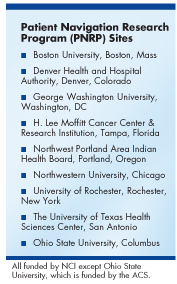$25 Million Patient Navigation Program Aims to Reduce Cancer Health Disparities in Targeted Communities
On June 29, 2005, President Bush signed into law the Patient Navigator Outreach and Chronic Disease Prevention Act of 2005 (H.R. 1812). This legislation authorized the National Cancer Institute (NCI) to oversee the distribution of $25 million in competitive 5-year grants to help underserved communities access health care services.
On June 29, 2005, President Bush signed into law the Patient Navigator Outreach and Chronic Disease Prevention Act of 2005 (H.R. 1812). This legislation authorized the National Cancer Institute (NCI) to oversee the distribution of $25 million in competitive 5-year grants to help underserved communities access health care services. The Patient Navigation Research Program (PNRP) aims to ameliorate health disparities among communities of lower socioeconomic status, racial/ethnic minorities, and rural populations nationwide.
H.R. 1812 was inspired by Harold Freeman, MD, a pioneering physician who is currently medical director of the Ralph Lauren Center for Cancer Care and Prevention in Harlem and director of the NCI's Center to Reduce Cancer Health Disparities (CRCHD). In 1990, Dr. Freeman implemented a novel patient navigator program to combat reported poor survival rates of breast cancer patients treated at Harlem Hospital Center, most of whom were African American, uninsured, and diagnosed at a late stage. Results of the 6-year study showed dramatic improvement. The percentage of women who presented with early-stage breast cancer increased sevenfold, and patients' 5-year survival rates significantly increased from 39% to 70% due to patient navigation and screening. Dr. Freeman's work served as the model for nine PNRP sites (see Table).

The PNRP's primary goal is to increase the proportion of patients who receive timely follow-up diagnostic evaluations and treatment after an abnormal breast, cervical, colorectal, or prostate screen. While most prior patient navigator programs primarily employed a health communicator/social worker, several of the PNRP sites have opted for a two- or three-pronged approach that incorporates a clinical or registered nurse and a social worker as well as lay health navigators.
The patient navigator connects patients to resources and support systems, streamlines appointments and paperwork, helps patients access financial services, assists with travel to appointments, reduces patients' fear and anxiety, identifies appropriate social services, and tracks outcomes and interventions.
Dr. Freeman has said that "there is a critical window of opportunity to save lives from cancer between the point of an abnormal finding and resolution by further diagnosis and treatment. The principal responsibility of The Patient Navigator is to eliminate any barrier that the patient may encounter to obtaining timely diagnosis after an abnormal finding." Identified barriers included lack of insurance, poor social support, coping styles, health beliefs such as fatalism, and poor health literacy skills.[1]
Other existing patient navigator programs that supply support to cancer patients in the United States include the American Cancer Society Patient Navigation Services; the Medicare Navigator Program, a demonstration project at six sites; and the NCI-funded Cancer Disparities Research Partnership (CDRP), which provides a trained, culturally competent individual to assist cancer patients in navigating through radiation oncology care and accessing clinical trials.
The need for this navigator project for the targeted four cancers and populations is evident because of disparities in outcomes and high mortality rates from these malignancies, many of which could be prevented with screening and early treatment. In 1986, the ACS "Special Report on Cancer in the Economically Disadvantaged" concluded that poorer cancer outcomes in African Americans, compared with white Americans, are primarily related to lower socioeconomic status in African Americans, and that irrespective of race, poor Americans have a 10% to 15% lower 5-year survival.[2] According to SEER Program data, African Americans have the highest cancer mortality rates, compared with any other racial or ethnic group in the United States. For cervical cancer, the death rate is 50% higher among Hispanic women than among non-Hispanic white women, which can be attributed to delayed follow-up after an abnormal screen.
PNRP to Provide Outcomes Data
There is little in the literature concerning the effectiveness of patient navigation, because there has been no large program able to effectively evaluate methods involved in patient navigation.[2] The PNRP addresses common research outcomes such as time to diagnosis and treatment, cost-effectiveness, and patient satisfaction. The program paves the way for other health care facilities that wish to evaluate the efficacy and cost-effectiveness of integrating patient navigation services into their systems.
References:
1. Freeman HP: Poverty, culture, and social injustice: Determinants of cancer disparities. CA Cancer J Clin 54(2):72-77, 2004.
2. Dohan D, Schrag D: Using navigators to improve care of underserved patients. Cancer 104(4):848-855, 2005.
2 Commerce Drive
Cranbury, NJ 08512
All rights reserved.